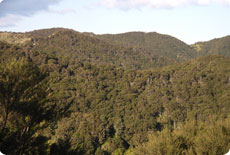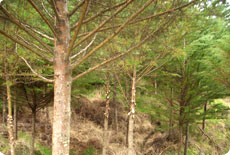Free phone within New Zealand: 0800 123 733
Email: [email protected]
Forestry and the ETS
 ETS details for forestry are more advanced than other sectors due to work undertaken for the Permanent Forest Sink Initiative (PFSI). The PFSI was developed as a separate Kyoto afforestation programme prior to the ETS being established.
ETS details for forestry are more advanced than other sectors due to work undertaken for the Permanent Forest Sink Initiative (PFSI). The PFSI was developed as a separate Kyoto afforestation programme prior to the ETS being established.
Under the ETS there are two types of forest; those existing before 1990, called pre Kyoto forests, and those established after 1989, called Kyoto Forests.
Opportunities for emission credits exist under the ETS for Kyoto forests (post 1989).
Pre-1990 Forests
Allocation Plan
Owners of pre-1990 forest land are entitled to an allocation of creidts as partial compensation for the deforestation rules. The table below outlines how much a landowner can apply for depending on land ownership dates.
| Land Ownership Date | 1st Tranch of Units (2012) | 2nd Tranch of Units (2013) | Total |
|---|---|---|---|
Owned before 31 October 2002 |
23 | 37 | 60 |
| Owned between 1 Nov 2002 and 1 July 2010 | 15 | 24 | 39 |
Owned after 1 July 2010 |
0 | 0 | 0 |
Depending on international negoiations the second tranch of units may not be paid out. If forestry "offsetting" is allowed, i.e. deforesting one area and planting trees in another then the second tranch will not be paid out, if offestting is not built into the international forest rules then it is likley to be paid out.
The deadline for applying for this allocation of units is 30 November 2011.
Deforestation
As of the 1st of January 2008, owners of pre-Kyoto forests (pre 1990) who deforest the land and turn it into an alternative land use (e.g. agriculture) will be liable for a deforestation penalty. This penalty will be in the form of paying back to the Government the number of emission units (NZUs) equivalent to what was stored in the forest. ETS information on forestry shows that on average there will be 800 NZUs per hectare allocated for a mature pine forest. At an estimated price of $25 per NZU this equates to $20,000 per hectare.
Exemptions
There are a few exceptions to the deforestation penalty, these include:
- Where the total forest area belonging to a legal entity is less than 50 hectares the landowner is exempt from a deforestation penalty.
- Any areas cleared under 2 hectares will be exempt.
- Where weed control of forested areas is recognised as a problem, e.g. the tree species is generally encountered as wildings, clearing, is exempt.
- Third party deforestation, eg line companies. Where deforestation is imposed by third party the deforestation liability is transferred to that party.
The deadline for applying for a less than 50ha exemption is 30 September 2011.
The deadline for applying for the 1st round of weed exemption was 30 October 2010 - for clearance between 2008 and 2012. It is likley that another round of weed exemptions will be announced for future weed clearance.
Kyoto Forests (after 1989)
Unlike other sectors, participation in the ETS for forestry is voluntary for Kyoto Forests.
Under the ETS there are several options for forest owners who establish Kyoto Forests, these are:
- Forestry under the ETS
- The Permanent Forest Sink Initiative
- Afforestation Grant Scheme
- East Coast Forestry Project
 Forestry under the ETS
Forestry under the ETS
Forestry under the ETS is not restricted by species or harvesting regime.
There is no covenant on the land title.
Harvesting incurs an emission liability which has to be accounted for during the emission accounting period in which they occur.
Forestry was brought into the ETS on 1 January 2008. The first accounting period was from 1 Jan to 31 Dec 2008. Carbon stocks can be assessed either annually or every five years (or associated Kyoto commitment period).
All costs of direct administration will be recovered from landowners of forests. The costs have not yet been determined.
 Permanent Forest Sink Initiative
Permanent Forest Sink Initiative
The point of difference under the PFSI is the "higher" standards required (such as continuous cover harvesting), and a covenant with the crown being registered on the title of the land binding all future land owners. Under the PFSI there will be a guaranteed allocation of AAUs and the option to opt out after 50 years, provided that all claimed credits are repaid to the crown. Changes to the PFSI mean all qualifying forests (exotic and indigenous) are eligible to enter the program from 1990. For more information on the PFSI click here.
Afforestation Grant Scheme
 An Afforestation Grant Scheme will be available to landowners who wish to establish a forest on Kyoto compliant land but do not wish to join the ETS. This will be a tender process which may assist the afforestation of plantation forests, planted indigenous forests or natural reversion. Under this programme the Government will retain all NZUs generated by the new forest for 10 years after planting and will also cover all liabilities. This will mean that landowners will get assistance for establishing a forest and they will be able to harvest and change land use without penalty.
An Afforestation Grant Scheme will be available to landowners who wish to establish a forest on Kyoto compliant land but do not wish to join the ETS. This will be a tender process which may assist the afforestation of plantation forests, planted indigenous forests or natural reversion. Under this programme the Government will retain all NZUs generated by the new forest for 10 years after planting and will also cover all liabilities. This will mean that landowners will get assistance for establishing a forest and they will be able to harvest and change land use without penalty.
For more information on the Afforestation Grant Scheme, please click here.
 East Coast Forestry Project
East Coast Forestry Project
The East Coast Forestry Project (ECFP) will continue as an independent erosion control program. If a landowner receives an ECFP grant and chooses to enter the PFSI the ECFP grant remains the same. However, if a landowner wishes to participate in the ETS their ECFP grant is likely to be reduced. The Ministry of Agriculture and Fisheries has explained that as the ETS doesn't have the harvesting restrictions of the PFSI and landowners may realise income from the harvested timber. For more information on the East Coast Forestry Project please click here.
A landowner will not be able to claim the ECFP and the AGS grants on the same forest.
Please see info sheets here to learn more about forestry and the ETS and how to apply to be a participant in the ETS.